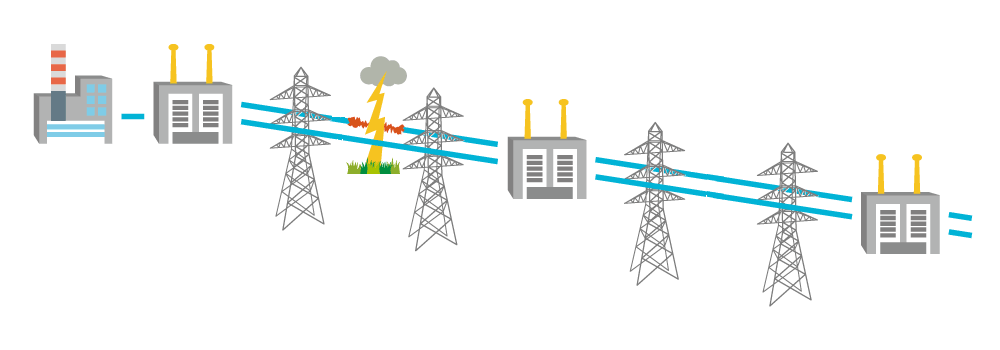



-
- Free Word Search




There are three types of power outages: "momentary voltage drop," "momentary interruption," and "power outage," as well as "momentary interruptions."
Here, we will explain three types of power troubles that occur when lightning strikes power line A, as shown in the figure below.


The electricity that leaves the power plant and is sent over two lines is combined into one at a substation along the way. It is then split into two lines again and combined at the next substation. Therefore, the moment lightning strikes transmission line A, the voltage also drops within the substation, causing a phenomenon in which the voltage on the receiving side of all of the lines A, B, C, and D that receive electricity from there also drops.
This voltage drop occurs only at the moment when lightning strikes, and generally recovers within 1/000 to 10/1000 of a second. If the voltage does not recover, the power company will disconnect only the struck power line A between 0.02 and 2 seconds after the lightning strike.
As a result, voltage drops of up to two seconds may occur at A, B, C, and D, which power companies call a "momentary voltage drop."
Power line A, which was cut off due to failure to recover from the momentary sag, will automatically be re-transmitted after about one minute and will return to its normal state. The one minute it takes for power to be restored on power line A is defined by the power company as a momentary power outage.
Since it takes about one minute for automatic re-supply to occur, you might think that it cannot be called "instantaneous," but since a power outage of less than one minute is intentionally caused by the power company, the power company does not call it a "power outage."
The power company will automatically reconnect power to the disconnected transmission line A after about one minute. If the voltage is abnormal again when power is reconnected, power transmission on side A will be cut off again. The cause of the voltage abnormality will then be identified, but power to side A where the lightning strike occurred will remain cut off until the cause is eliminated.
Power companies define a power outage like this, lasting for more than one minute, as a "power outage."
As mentioned above, power companies define three types of power troubles: "instantaneous voltage drop," "instantaneous interruption (instantaneous power outage)," and "power outage." Note that the "instantaneous voltage drop" in "instantaneous voltage drop" and the "instantaneous interruption" in "instantaneous power outage" are both abbreviated to "shuntei." Because they are pronounced the same, it can be difficult to tell the difference just by hearing them, and it is important to note that the countermeasures for each may be different.
Momentary power outages and voltage drops are sometimes referred to as momentary interruptions. In general, the interruption of electricity when switching electricity intentionally is often referred to as momentary interruptions. In fact, momentary interruptions and voltage drops have the same definition, but the types of power outages defined by electric power companies are "momentary voltage drops (instantaneous voltage drops)," "momentary interruptions (instantaneous power outages)," and "power outages."
When lightning strikes an electric wire, it shorts out the wire and the ground, causing a voltage drop and resulting in a momentary sag. Although long-term power outages can also occur due to typhoons or other events that cut power lines, the main cause is lightning.
Whenever a power outage or momentary drop or interruption occurs, factory equipment may stop working, leading to breakdowns. Even if no breakdowns occur, it takes time to restart the equipment, which stops production during that time, resulting in reduced production efficiency.
In the past, there have been cases where a "momentary voltage drop" lasting less than 1/10 of a second has caused factories to suspend operations for more than two days, resulting in enormous damage.
As described above, momentary voltage drops and interruptions have a huge impact on production at factories and other production facilities. Therefore, it is necessary to use countermeasure devices to safely protect production facilities at factories and other facilities.
The best solution would be to install Uninterruptible Power Supplies (UPS) that can handle all voltage sags, interruptions, and power outages. However, if this is difficult due to cost or space constraints, a voltage sag countermeasure (compensation) device that only covers voltage sags is also an effective solution.
Power outages, momentary drops, and interruptions have a major impact on network environments and memory data. With the amount of data handled in offices increasing rapidly these days, failures of network devices and damage to PC servers and memory can have a major impact on business, including data loss.
In addition, it is inevitable that the impact will be felt in all places involving information and communications, such as ATM terminals, POS terminals, and commercial facilities.
The voltage sag detection method used by SANYO DENKI is performed at a speed faster than 1/1000 of a second. It detects voltage sags before they occur and regulates the voltage, so there is no interruption in the output voltage and current.
UPS is a device that constantly supplies a stable supply of electricity to a computer using electricity stored in an internal storage battery. It can handle instantaneous voltage drops, instantaneous interruptions, and power outages.
To avoid power outages and other power problems, it is common to use a UPS, but in the case of extra-high voltage power reception, there is also the option of making a contract with the power company for two lines. In this case, the probability of a "power outage" is reduced, so it can be said that a "momentary power outage countermeasure device" and a "momentary power drop compensation device" can be sufficient to deal with the problem.
When it detects a voltage drop, it instantly backs up power, preventing power problems at your facilities. Most voltage drop countermeasure (compensation) devices only cover voltage drops, but SANYO DENKI products also cover momentary interruptions.
Compared to an "Uninterruptible Power Supplies (UPS)" that covers voltage drops, power interruptions, and power outages, it has the advantage of being space-saving and inexpensive.
The main difference between our Voltage Dip Compensators and a UPS is the power storage device. UPS mainly uses lead-acid batteries, but Voltage Dip Compensators uses electric double-layer capacitors (capacitors). Electric double-layer capacitors are excellent at receiving and discharging large currents instantaneously, so they are used in devices that release large amounts of power for a short period of time, such as during momentary drops and interruptions. Some manufacturers use electrolytic capacitors in their instantaneous interruption countermeasure devices.
Also, there are three types of power supply methods for UPS, but there are only two types of power supply methods because there are no manufacturers that use Double Conversion Online method for momentary power interruption protection devices, and most generally use the "Passive Standby," which is accompanied by a momentary interruption of about 2 ms. SANYO DENKI uses the "Parallel Processing" which is interruption-free. As explained in the fifth lesson, Passive Standby causes a momentary interruption of about 2 to 10 ms when switching to Inverter power supply. For electrical equipment that cannot withstand this momentary interruption, we recommend SANYO DENKI 's Parallel Processing.
This time, we learned about the "types of power outages." In fact, power problems are not only caused by the power transmission side. Next time, we will learn about power problems caused by the power receiving side, that is, us, the electricity users.
Written by: Toshiyuki Nishizawa, Senior Sales Engineer, Sales Division, SANYO DENKI CO., LTD.
Update date: /release date: